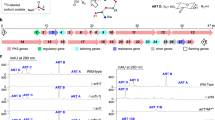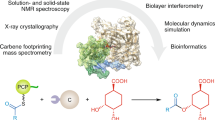Abstract
Polyketide synthases assemble diverse natural products with numerous important applications. The thioester intermediates in polyketide assembly are covalently tethered to acyl carrier protein domains of the synthase. Several mechanisms for polyketide chain release are known, contributing to natural product structural diversification. Here, we report a dual transacylation mechanism for chain release from the enacyloxin polyketide synthase, which assembles an antibiotic with promising activity against Acinetobacter baumannii. A non-elongating ketosynthase domain transfers the polyketide chain from the final acyl carrier protein domain of the synthase to a separate carrier protein, and a non-ribosomal peptide synthetase condensation domain condenses it with (1S,3R,4S)-3,4-dihydroxycyclohexane carboxylic acid. Molecular dissection of this process reveals that non-elongating ketosynthase domain-mediated transacylation circumvents the inability of the condensation domain to recognize the acyl carrier protein domain. Several 3,4-dihydroxycyclohexane carboxylic acid analogues can be employed for chain release, suggesting a promising strategy for producing enacyloxin analogues.
This is a preview of subscription content, access via your institution
Access options
Access Nature and 54 other Nature Portfolio journals
Get Nature+, our best-value online-access subscription
$29.99 / 30 days
cancel any time
Subscribe to this journal
Receive 12 print issues and online access
$259.00 per year
only $21.58 per issue
Buy this article
- Purchase on Springer Link
- Instant access to full article PDF
Prices may be subject to local taxes which are calculated during checkout






Similar content being viewed by others
Data availability
The genome sequence of B. ambifaria BCC0203 has been deposited in the European Nucleotide Archive (accession no. ERS782625). All other data are available from the authors upon request.
References
Hertweck, C. The biosynthetic logic of polyketide diversity. Angew. Chem. Int. Ed. 48, 4688–4716 (2009).
Fischbach, M. A. & Walsh, C. T. Assembly-line enzymology for polyketide and nonribosomal peptide antibiotics: logic, machinery and mechanisms. Chem. Rev. 106, 3468–3496 (2006).
Du, L. & Lou, L. PKS and NRPS release mechanisms. Nat. Prod. Rep. 27, 255–278 (2010).
Tang, G.-L., Cheng, Y.-Q. & Shen, B. Leinamycin biosynthesis revealing unprecedented architectural complexity for a hybrid polyketide synthase and nonribosomal peptide synthetase. Chem. Biol. 11, 33–45 (2004).
Awodi, U. R., Ronan, J. L., Masschelein, J., de Los Santos, E. L. C. & Challis, G. L. Thioester reduction and aldehyde transamination are universal steps in actinobacterial polyketide alkaloid biosynthesis. Chem. Sci. 8, 411–415 (2017).
Mullowney, M. W., McClure, R. A., Robey, M. T., Kelleher, N. L. & Thomson, R. J. Natural products from thioester reductase containing biosynthetic pathways. Nat. Prod. Rep. 35, 847–878 (2018).
Mo, S. J. et al. Elucidation of the Streptomyces coelicolor pathway to 2-undecylpyrrole, a key intermediate in undecylprodiginine and streptorubin B biosynthesis. Chem. Biol. 15, 137–148 (2008).
Hu, D. X., Withall, D. M., Challis, G. L. & Thomson, R. J. Structure, chemical synthesis and biosynthesis of prodiginine natural products. Chem. Rev. 116, 7818–7853 (2016).
Sun, Y. et al. In vitro reconstruction of tetronate RK-682 biosynthesis. Nat. Chem. Biol. 6, 99–101 (2010).
Watanabe, T., Izaki, K. & Takahashi, H. New polyenic antibiotics active against Gram-positive and -negative bacteria. I. Isolation and purification of antibiotics produced by Gluconobacter sp. W-315. J. Antibiot. ( Tokyo ) 35, 1141–1147 (1982).
Watanabe, T. et al. New polyenic antibiotics active against Gram-positive and Gram-negative bacteria. IV. Structural elucidation of enacyloxin IIa. J. Antibiot. ( Tokyo ) 45, 470–475 (1992).
Mahenthiralingam, E. et al. Enacyloxins are products of an unusual hybrid modular polyketide synthase encoded by a cryptic Burkholderia ambifaria genomic island. Chem. Biol. 18, 665–677 (2011).
Cetin, R. et al. Enacyloxin IIa, an inhibitor of protein biosynthesis that acts on elongation factor Tu and the ribosome. EMBO J. 15, 2604–2611 (1996).
Parmeggiani, A. et al. Enacyloxin IIa pinpoints a binding pocket of elongation factor Tu for development of novel antibiotics. J. Biol. Chem. 281, 2893–2900 (2006).
Zuurmond, A. M., Olsthoorn-Tieleman, L. N., Martien de Graaf, J., Parmeggiani, A. & Kraal, B. Mutant EF-Tu species reveal novel features of the enacyloxin IIa inhibition mechanism on the ribosome. J. Mol. Biol. 294, 627–637 (1999).
Helfrich, E. J. N. & Piel, J. Biosynthesis of polyketides by trans-AT polyketide synthases. Nat. Prod. Rep. 33, 231–316 (2016).
Huang, Y., Tang, G.-L., Pan, G., Chang, C.-Y. & Shen, B. Characterization of the ketosynthase and acyl carrier protein domains at the LnmI nonribosomal peptide synthetase–polyketide synthase interface for leinamycin biosynthesis. Org. Lett. 18, 4288–4291 (2016).
He, H.-Y., Tang, M.-C., Zhang, F. & Tang, G.-L. Cis-double bond formation by thioesterase and transfer by ketosynthase in FR901464 biosynthesis. J. Am. Chem. Soc. 136, 4488–4491 (2014).
Flannagan, R. S., Linn, T. & Valvano, M. A. A system for the construction of targeted unmarked gene deletions in the genus Burkholderia. Environ. Microbiol. 10, 1652–1660 (2008).
Li, W. et al. Broad spectrum antibiotic activity and disease suppression by the potential biocontrol agent Burkholderia ambifaria BC-F. Crop Prot. 21, 129–135 (2002).
Thomas, I., Martin, C. J., Wilkinson, C. J., Staunton, J. & Leadlay, P. F. Skipping in a hybrid polyketide synthase: evidence for ACP-to-ACP chain transfer. Chem. Biol. 9, 781–787 (2002).
Lin, S., Van Lanen, S. G. & Shen, B. A free-standing condensation enzyme catalyzing ester bond formation in C-1027 biosynthesis. Proc. Natl Acad. Sci. U.S.A. 106, 4183–4188 (2009).
Kosol, S. et al. Structural basis for chain release from the enacyloxin polyketide synthase. Nat. Chem. https://doi.org/10.1038/s41557-019-0335-5 (2019).
Ye, Z., Musiol, E. M., Weber, T. & Williams, G. J. Reprogramming acyl carrier protein interactions of an acyl-CoA promiscuous trans-acyltransferase. Cell Chem. Biol. 21, 636–646 (2014).
Acknowledgements
This research was supported by grants from the BBSRC (BB/L021692/1 to G.L.C., E.M. and J.P. and BB/K002341/1 to G.L.C.), the European Commission (through a Marie Sklodowska-Curie Fellowship to J.M., contract no. 656067) and the Research Foundation Flanders (to J.M.). Support from the University of Warwick through a fellowship from the Institute of Advanced Study (to P.K.S.) and a PhD studentship (to C.H.) is acknowledged. The Bruker maXis Impact and maXis II UHPLC-ESI-Q-TOF-MS systems used in this research were funded by the BBSRC (BB/K002341/1 and BB/M017982/1, respectively). G.L.C. is the recipient of a Wolfson Research Merit Award from the Royal Society (WM130033). Z.L.Y. was funded by a Cardiff University Undergraduate Research Opportunities Programme (CUROP) award to C.J. and E.M. The authors thank M. Tosin for providing the Sfp, PanK, PPAT and DPCK expression vectors. Correspondence and requests for materials should be addressed to G.L.C.
Author information
Authors and Affiliations
Contributions
J.M., P.K.S. and G.L.C. designed the experiments. P.K.S. cloned the B. ambifaria genes into pET151 and created the site-directed mutants. J.M., P.K.S. and C.H. carried out the in vitro biochemical experiments. C.J., Z.L.Y. and E.M. identified strain BCC0203 as being amenable to genetic manipulation, established selection conditions and constructed and complemented the B. ambifaria gene deletion mutants. J.P. supervised sequencing and assembly of the B. ambifaria BCC0203 genome. C.J. analysed the genome sequence of strain BCC0203 and made the initial comparisons to the genome of the AMMD strain. C.H., R.H., D.M.R., P.K.S. and J.M. synthesized substrates. J.M. and G.L.C. wrote the manuscript with input from the other authors.
Corresponding author
Ethics declarations
Competing interests
The broad substrate specificity of Bamb_5915, exploited for the production of enacyloxin analogues, is the subject of International (PCT) Patent Application no. PCT/GB2018/051058 (applicant, University of Warwick; inventors, G.L.C., J.M., C.H., X. Jian; status of application, filed 23 April 2018).
Additional information
Publisher’s note Springer Nature remains neutral with regard to jurisdictional claims in published maps and institutional affiliations.
Supplementary information
Supplementary Information
The Supplementary Information file contains details of the methods used, and Supplementary Figs. 1–15 and Supplementary Tables 1–2
Rights and permissions
About this article
Cite this article
Masschelein, J., Sydor, P.K., Hobson, C. et al. A dual transacylation mechanism for polyketide synthase chain release in enacyloxin antibiotic biosynthesis. Nat. Chem. 11, 906–912 (2019). https://doi.org/10.1038/s41557-019-0309-7
Received:
Accepted:
Published:
Issue Date:
DOI: https://doi.org/10.1038/s41557-019-0309-7
This article is cited by
-
Decrypting the programming of β-methylation in virginiamycin M biosynthesis
Nature Communications (2023)
-
Unrealized targets in the discovery of antibiotics for Gram-negative bacterial infections
Nature Reviews Drug Discovery (2023)
-
No job too small for a giant enzyme
Nature Chemical Biology (2023)
-
Enzymatic assembly of the salinosporamide γ-lactam-β-lactone anticancer warhead
Nature Chemical Biology (2022)
-
Natural products in drug discovery: advances and opportunities
Nature Reviews Drug Discovery (2021)



